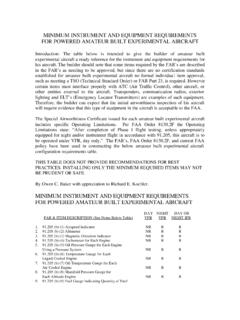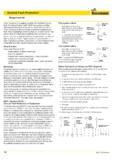Transcription of Institutional arrang ements for roads - National Treasury
1 10. roads Introduction South Africa's road infrastructure is relatively well developed Road infrastructure supports compared to most sub-Saharan African countries and even by domestic and regional needs international standards, particularly in the urbanised areas. Road and is an effective catalyst for infrastructure supports both domestic and regional needs and is an spatial development, and the effective catalyst for spatial development, and the development of development of businesses, transport systems and human business and residential areas.
2 Road infrastructure also facilitates the settlements mobility of goods and people. Road infrastructure provides connections to the external world, and specifically, access to markets and public services, such as ambulances and police services. The building of roads creates jobs, especially if labour intensive methods are used, which helps alleviate poverty and unemployment. The 2010 FIFA World Cup was a catalyst for developing road infrastructure, particularly in the host cities. However, much more development still needs to take place.
3 Social and economic development is constrained where there is a lack of reliable access to services, materials and markets for people and firms. roads infrastructure is key to this access. This requires not only the installation of a road, but also its regular maintenance to ensure that access is sustained. roads are expensive to develop and maintain. According to the Centre roads are expensive to for Scientific and Industrial Research (CSIR), the total asset value of develop and maintain South African roads in 2010 has been estimated at R1 trillion, with the value of the paved road network probably making up about 80 per cent of this (about R800 billion).
4 New roads and major repairs of existing roads typically cost about million per kilometre for a lightly trafficked paved rural road, while constructing and maintaining heavy freeway structures can cost tens of millions of rands per kilometre. 161. 2011 LOCAL GOVERNMENT BUDGETS AND EXPENDITURE REVIEW. Government in all spheres is responsible for funding the maintenance of the current road infrastructure, as well as providing new roads where necessary. Yet there is ample evidence pointing to road and storm water infrastructure not being maintained adequately, and this is worsened by the continual increase in traffic volumes and heavy rains.
5 It is essential that the enormous value of the country's roads assets are not allowed to deteriorate further, as the costs of restoration would be extremely high. Road construction at the provincial and local level needs to be informed by projected mobility and settlement patterns, which take into account plans for key economic nodes and spatial development. This should become an intrinsic part of integrated planning and development by all spheres of government. Municipalities need to enhance their capacity to effectively perform their role in relation to roads .
6 Municipalities' integrated transport plans should provide a long term vision of local mobility, as a guide to the investment in and maintenance of road infrastructure. Municipalities also need to increase their investments in storm water management systems, especially in urban areas to mitigate incidences of flooding that are likely to be associated with the extreme weather conditions associated with climate change. This chapter gives an overview of: the Institutional arrangements for roads the state of the country's roads funding and expenditure on road infrastructure and maintenance policy and funding developments in the roads sector.
7 Institutional arrangements for roads Schedules 4 and 5 of the Constitution outline the various transport and road infrastructure functions of the different spheres of government. In terms of Part A of Schedule 5 of the Constitution, provincial roads and traffic are an exclusive provincial function, while municipal roads , traffic and parking are municipal functions in terms of Part B of Schedule 5. Municipalities are responsible for investments in local infrastructure, including the construction and maintenance of roads and streets that are within their jurisdiction and proclaimed as municipal roads .
8 The National Department of Transport plays a largely facilitative and regulatory role. It is responsible for the development of policy and the legislative framework that is implemented through provincial departments, local government and public entities. The main transport policies are spelt out in two key policy documents the 1996 White Paper on National Transport Policy, and the Moving South Africa document, which emanated from the white paper and sets out an integrated strategy for improving and maintaining transport infrastructure in South Africa.
9 162. CHAPTER 10: roads . Effective Institutional arrangements and proper coordination remain a Effective Institutional challenge in road infrastructure delivery due to the broad arrangements and proper constitutional assignment of functions for roads . The challenge coordination remain a emanates from the fact that National roads pass through provincial and challenge in road infrastructure municipal areas and provincial roads are located within municipal delivery areas. The expansion of a road network needs to be communicated across all spheres to achieve alignment within the context of integrated road and transport planning.
10 National , provincial and local government, as well as their associated agencies, each have responsibilities for sections of the road network. Excellent capacity and capability exist in the National road authorities (the South African National roads Agency Limited (SANRAL)) and limited capacity at some provincial and local roads authorities, with the exception of metros and secondary cities. While SANRAL has managed to build and retain expert technical staff over the years, this has not been the case in other public sector agencies.

















